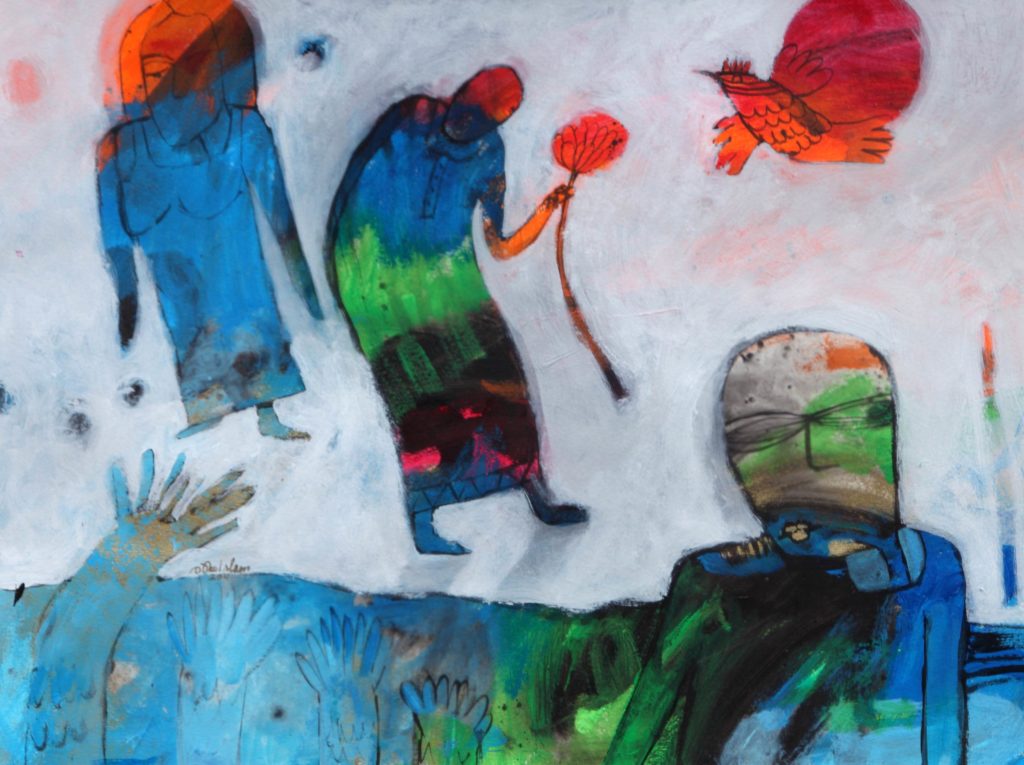Courtesy of the Hindiyeh Museum of Art
 ISLAM KAMIL ALI
ISLAM KAMIL ALI
UNTITLED (2011)
47 x 62 CM, ACRYLIC ON CANVAS
Courtesy of the Hindiyeh Museum of Art
 ISLAM KAMIL ALI
ISLAM KAMIL ALI
UNTITLED (2011)
47 x 62 CM, ACRYLIC ON CANVAS
Translated by ROBIN MOGER
Not many of us knew Sharif. He had been gone from the village for more than thirty years, and the few times his name came up, the person in question would glance around and lower their voice almost to a whisper. Men’s heads would cluster together in brief and hasty conference. And should his father, Sheikh Abdennabi Wadd Saleh, appear at the head of the alley and walk their way, or his mother, Hagga Amina Bint Suleiman, approach the store, they would fall silent or change the conversation.
With ANIKA FAJARDO

Name: Anika Fajardo
Current city or town: Minneapolis, Minnesota
Minneapolis is known as the “city of lakes” because of the five large bodies of water nestled in among the city blocks of houses and small businesses. The lakes give the city a vacation feel during the summer. You can go to the beach, bike and walk, and eat ice cream.

They jog past my window. A clump of three white-haired men, a tight pyramid formation, the front two shoulder to shoulder, the third right on their heels. And I’ll be honest, my first thought is not charitable. “Fucking men,” I think, taking a swig of my coffee. “They never think the rules apply to them. Do they think they’re invincible?”
My boy is on the floor again. I’ve just told him he has to get in the shower, before dinner, after homework, after only five minutes of TV.
“What?” he protested in a drawn-out whine that contorted his face into a buskin tragedy mask before collapsing onto the floor. His body, prone and straight, swivels from side to side. He pulls his knees into his chest. Now he thrusts his feet down, then back, and almost behind him, as if doing a hamstring stretch. However he moves, thrashing, flailing, it is not vertical. To move up or around or about—even if stomping, even if screaming, even while crying out—would convey a sense of acceptance. “I don’t want to do what you ask, but I’m willing!” such a movement would say.
Mohammad Ibrahim Nawaya’s story “To Be Led from Behind,” translated from the Arabic by Robin Moger, has been chosen to appear in Sonder Press’s 2020 award anthology The Best Small Fictions. The anthology, now in its sixth year, presents one hundred and twenty-six pristinely crafted pieces from an array of authors. It features micro fiction, flash fiction, haibun stories, and prose poetry.
The Bath Flash Fiction Award writes “[T]he beauty of an anthology such as this, pulling together the best of the form, is that you will always encounter something new, something different, something that pushes the boundaries of flash further than before. If this anthology proves nothing else, it is that small fiction in all its forms continues to go from strength to strength, as does the series itself.”
Congrats to Mohammad! Read “To Be Led from Behind” here, or check out other pieces from our Issue 17 portfolio of Arabic stories from Syria,.
Browse more of The Common’s prize-winning pieces here.
JULIA PIKE interviews EMMA COPLEY EISENBERG

The Third Rainbow Girl is not an easy book to categorize; nor is it always an easy book to read, but it’s certainly worthy of the latter. The book tells the story of a crime committed in Pocahontas County West Virginia in 1980, which was known as the Rainbow Murders. Two women, Vicky Durian and Nancy Santomero, were found dead from gunshot wounds in a remote corner of the county. The girls, along with their friend, Elizabeth Johndrow, had hitchhiked toward Pocahontas County to attend the Rainbow Gathering, an annual, weeklong meeting that celebrates peace and harmony. Johndrow decided not to go at the last minute. Because of where the bodies were found, as well as narratives describing the men of the town as violent and unfriendly to outsiders, many suspected that the crimes had been committed by a local. Nine men from the county were embroiled in the case, and one, Jacob Beard, was eventually charged and imprisoned for the murder, despite the 1984 confession of serial killer Joseph Paul Franklin.
Years later, Emma Copley Eisenberg moved to Pocahontas County to work for AmeriCorps VISTA as a volunteer at a nonprofit designed to empower girls. She spent a year working with girls during the day and drinking and playing bluegrass with local men at night. “I felt ruined by my time in Pocahontas County—no place would ever be so good,” Eisenberg writes. But like every story told in the book, this one is not so simple. “I felt harmed,” Eisenberg writes, “and also that I had harmed others with my weakness and my silence and my actions, and I didn’t know how to make those two feelings stay together. Every time I grasped one of them, the other seemed to fade away.” It was at a writing group in Pocahontas County that Eisenberg first heard the story of the Rainbow Murders, and that her story and the story of the crimes first became intertwined. In The Third Rainbow Girl, Eisenberg unpacks the complex history of the region, and how this history affected the treatment of the crimes and the resulting communal trauma.
The Common’s former Wood Fellow Julia Pike spoke by phone with Eisenberg about memory, positionality, reading and writing about Appalachia, and how we love a place through writing.
TC: I’d love to start by talking about your short story “Forty-Four Thousand Pounds,” which was published in The Common’s Issue 15. The story has multiple parts—in one, the protagonist, Kendra, is in her father’s truck as he drives across the country, in another, years later, Kendra tells her friend/ girlfriend Carla that she’s leaving their hometown, and in yet another, furthest in the future, Kendra bikes around Philadelphia. I’m interested in the way the story handles time and memory, and curious about why you chose to tell it in this particular way.
Novel by MARGARITA KHEMLIN
Translated from the Russian by LISA C. HAYDEN
Reviewed by OLGA ZILBERBOURG
The year is 1950 in Kiev. A twenty-year-old college student, Maya Klotsvog, falls in love with her professor, Viktor Pavlovich. He’s eight years older and married. One day, the professor’s wife, Darina Dmitrievna, catches up with Maya at the tram stop and reveals that her husband loves Maya and has asked for a divorce. He wants to marry Maya and have children with her. But Darina Dmitrievna adds something else: “You’re Jewish and your children would be half Jewish. And you yourself know what the situation is now. You read the papers, listen to the radio. And then that shadow would fall on Viktor Pavlovich himself, too. Anything can happen. Don’t you agree? Babi Yar over there is full of half-bloods.”
During this difficult time, we want to take the opportunity to highlight a few educational resources we offer that are readily available for at-home learning. Even while stuck at home, you can use works from The Common to connect your students to new voices and perspectives from around the world, while also deepening their own sense of place. Several recently published web features will also offer students examples of how literature can help us to reflect upon the present moment.